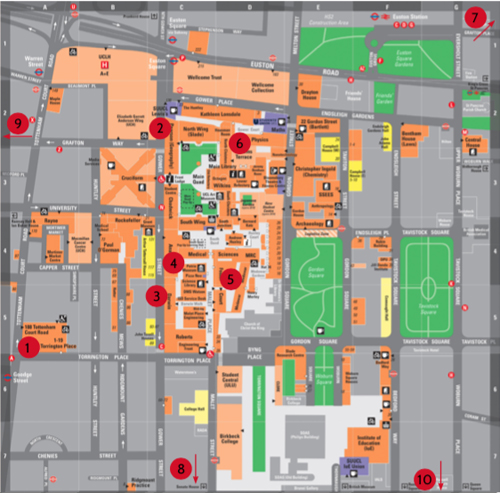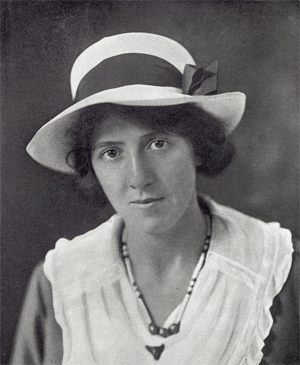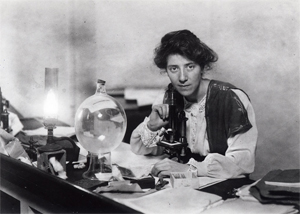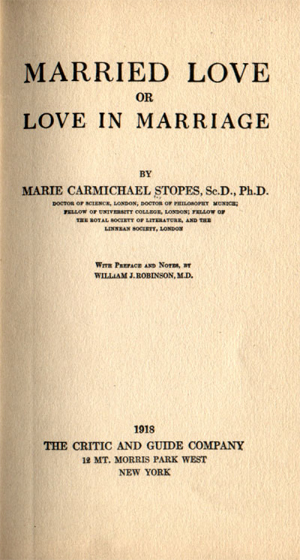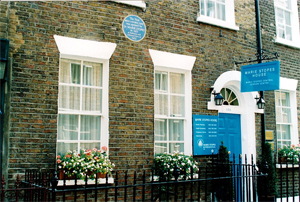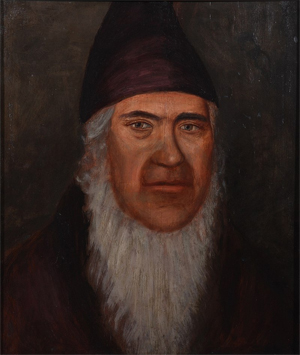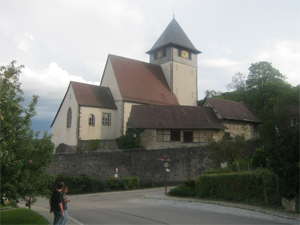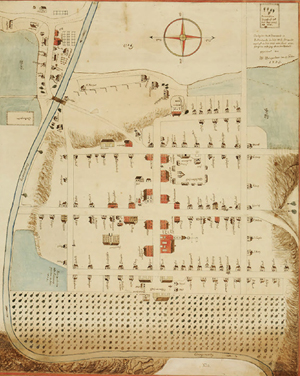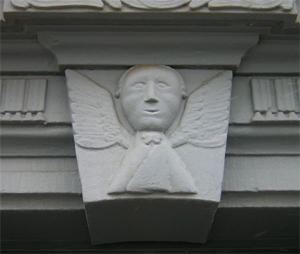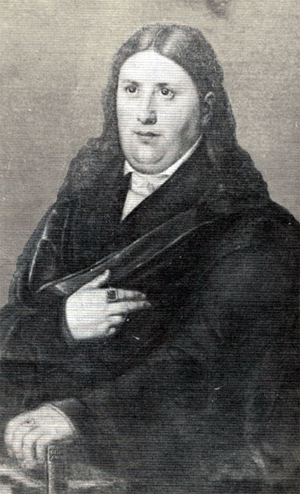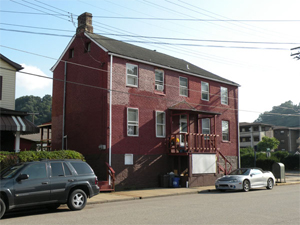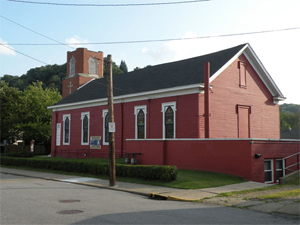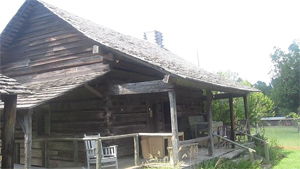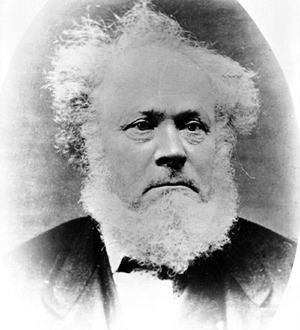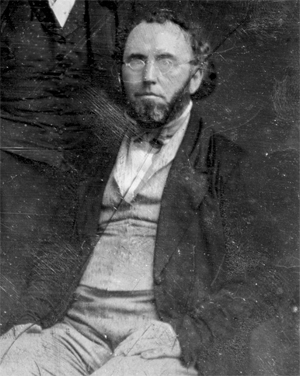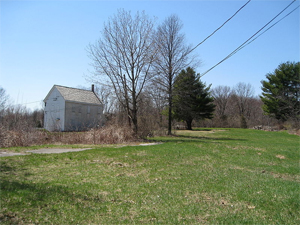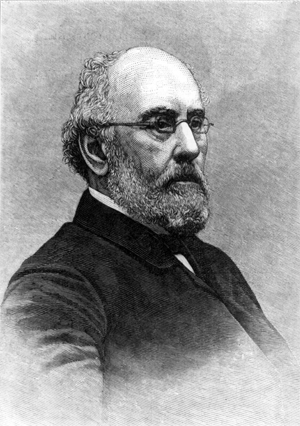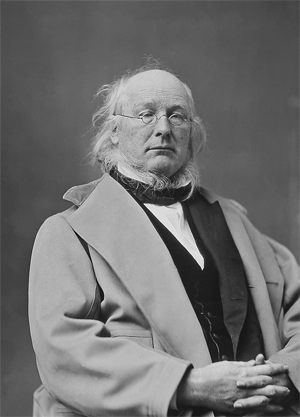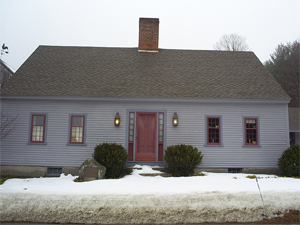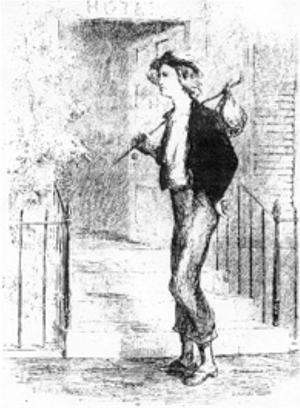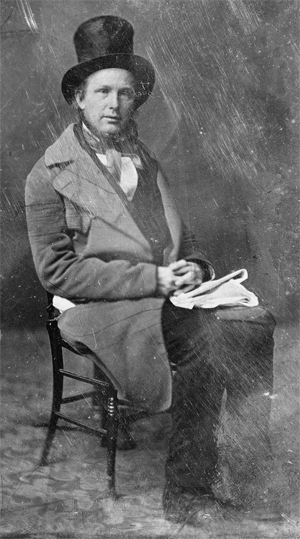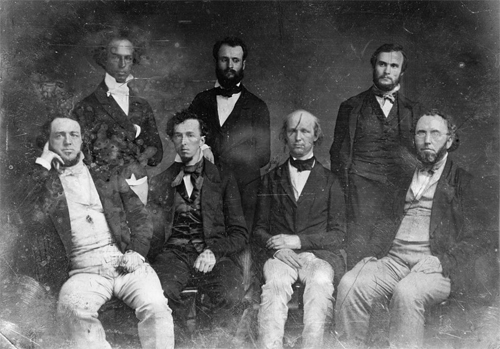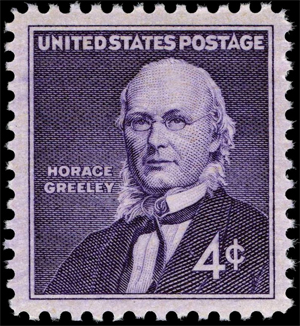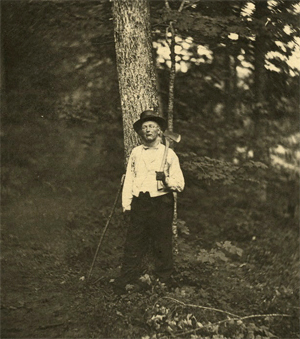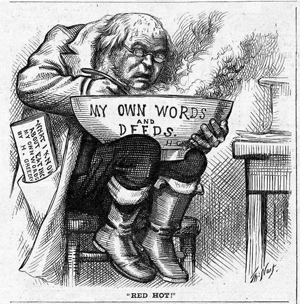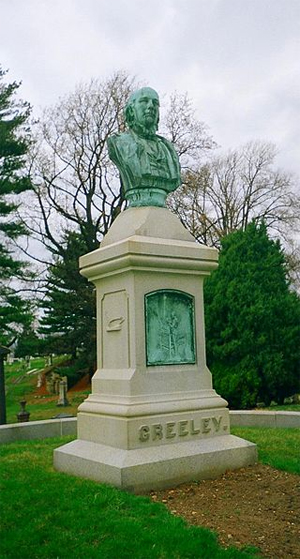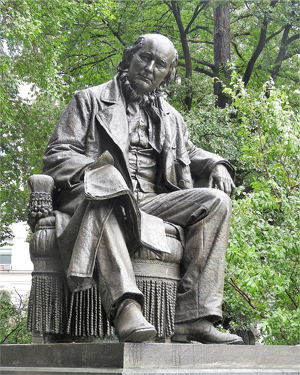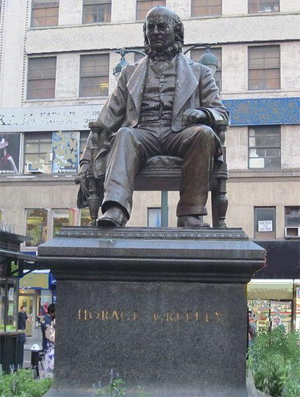J. B. S. Haldaneby Wikipedia
Accessed: 5/20/20
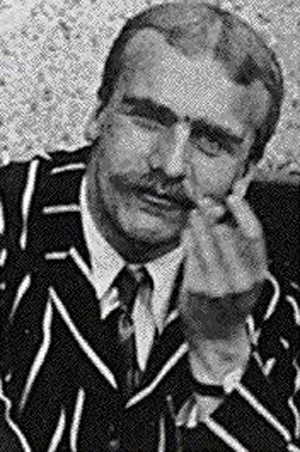
J. B. S. Haldane, FRS
Haldane in 1914
Born: 5 November 1892, Oxford, England
Died: 1 December 1964 (aged 72), Bhubaneswar, India
Citizenship: British (until 1961) Indian
Education: Eton College
Alma mater: University of Oxford
Known for: Oparin–Haldane hypothesis; Malaria resistance; Population genetics; Enzymology; Neo-Darwinism; Haldane's rule; Haldane's principle; Haldane's dilemma; Primordial soup; Heterotrophic theory; Fitness; Kin selection; Selection shadow
Spouse(s): Charlotte Franken (m. 1926; div. 1945); Helen Spurway (m. 1945–1964)
Awards: Darwin–Wallace Medal (1958); Darwin Medal (1952)
Scientific career
Fields: Biology Biostatistics
Institutions: University of Cambridge; University of California, Berkeley; University College London; Indian Statistical Institute, Calcutta
Academic advisors: Frederick Gowland Hopkins
Doctoral students: Helen Spurway; Krishna Dronamraju; John Maynard Smith
John Burdon Sanderson Haldane FRS (/ˈhɔːldeɪn/; 5 November 1892 – 1 December 1964[1][2]), nicknamed "Jack" or "JBS",[3] was a British-Indian scientist known for his work in the study of physiology, genetics, evolutionary biology, and mathematics. He made innovative contributions to the fields of statistics and biostatistics.
His article on abiogenesis in 1929 introduced the "primordial soup theory", and it became the foundation to build physical models for the chemical origin of life.[4] Haldane established human gene maps for haemophilia and colour blindness on the X chromosome, and codified Haldane's rule on sterility in the heterogametic sex of hybrids in species.[5][6] He correctly proposed that sickle-cell disease confers some immunity to malaria. He was the first to suggest the central idea of in vitro fertilisation, as well as concepts such as hydrogen economy, cis and trans-acting regulation, coupling reaction, molecular repulsion, the darwin (as a unit of evolution) and organismal cloning. In 1957 he articulated Haldane's dilemma, a limit on the speed of beneficial evolution which subsequently proved incorrect. He willed his body for medical studies, as he wanted to remain useful even in death.[7] He is also remembered for coining the words "clone" and "cloning" in human biology, and "ectogenesis".
Haldane's first paper in 1915 demonstrated genetic linkage in mammals. Subsequent works established a unification of Mendelian genetics and Darwinian evolution by natural selection whilst laying the groundwork for modern evolutionary synthesis and thus helped to create population genetics.
Haldane was a professed socialist, Marxist, atheist and humanist whose political dissent led him to leave England in 1956 and live in India, becoming a naturalised Indian citizen in 1961.Arthur C. Clarke credited him as "perhaps the most brilliant science populariser of his generation".[8][9] Nobel laureate Peter Medawar called Haldane "the cleverest man I ever knew".[10] According to Theodosius Dobzhansky, "Haldane was always recognized as a singular case"; and to Michael J. D. White, "the most erudite biologist of his generation, and perhaps of the century."[11]
Biography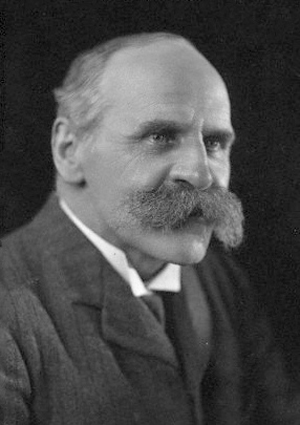 His father John Scott Haldane c. 1910Early life and education
His father John Scott Haldane c. 1910Early life and educationHaldane was born in Oxford to John Scott Haldane, a physiologist, scientist, a philosopher and a Liberal, and Louisa Kathleen Trotter, a Conservative. His younger sister, Naomi Mitchison, became a writer, and
his uncle was Viscount Haldane and his aunt the author Elizabeth Haldane.
Descended from an aristocratic and secular family[12] of the Clan Haldane, he would later claim that his Y chromosome could be traced back to Robert the Bruce.[13]
Robert I (11 July 1274 – 7 June 1329), popularly known as Robert the Bruce (Medieval Gaelic: Roibert a Briuis; modern Scottish Gaelic: Raibeart Brus; Norman French: Robert de Brus or Robert de Bruys; Early Scots: Robert Brus; Latin: Robertus Brussius), was King of Scotland from 1306 until his death in 1329. Robert was one of the most famous warriors of his generation, and eventually led Scotland during the First War of Scottish Independence against England. He fought successfully during his reign to regain Scotland's place as an independent country and is today revered in Scotland as a national hero.
-- Robert the Bruce, by Wikipedia
He grew up at 11 Crick Road, North Oxford.[14]
He learnt to read at the age of three, and at four, after injuring his forehead he asked the doctor, "Is this oxyhaemoglobin or carboxyhaemoglobin?". From age eight he worked with his father in their home laboratory where he experienced his first self-experimentation, the method he would later be famous for. He and his father became their own "human guinea pigs", such as in their investigation on the effects of poison gases. In 1899 his family moved to "Cherwell", a late Victorian house at the outskirts of Oxford with its own private laboratory.His formal education began in 1897 at Oxford Preparatory School (now Dragon School), where he gained a First Scholarship in 1904 to Eton. In 1905 he joined Eton, where
he experienced severe abuse from senior students for allegedly being arrogant. The indifference of authority left him with a lasting hatred for the English education system. However, the ordeal did not stop him from becoming Captain of the school. He studied mathematics and classics at New College at the University of Oxford and obtained first-class honours in mathematical moderations in 1912 and first-class honours in Greats in 1914.
He became engrossed in genetics and presented a paper on gene linkage in vertebrates in the summer of 1912. His first technical paper, a 30-page long article on haemoglobin function, was published that same year, as a co-author alongside his father.[15]
CareerHis education was interrupted by the
First World War during which he fought in the British Army, being commissioned a temporary second lieutenant in the 3rd Battalion of the Black Watch (Royal Highland Regiment) on 15 August 1914.[16] He was promoted to temporary lieutenant on 18 February 1915 and to temporary captain on 18 October.[17][18]
He served in France and Iraq, where he was wounded. He relinquished his commission on 1 April 1920, retaining his rank of captain.[19] For his ferocity and aggressiveness in battles,
his commander called him the "bravest and dirtiest officer in my Army."[20]
Between 1919 and 1922
he was a Fellow of New College, Oxford,[21] where he researched physiology and genetics. He then moved to the University of Cambridge, where he accepted a readership in Biochemistry and taught until 1932.[12] From 1927 until 1937 he was also Head of Genetical Research at the John Innes Horticultural Institution.[22] During his nine years at Cambridge, Haldane worked on enzymes and genetics, particularly the mathematical side of genetics.[12] He was the Fullerian Professor of Physiology at the Royal Institution from 1930 to 1932 and in 1933 he became
full Professor of Genetics at University College London, where he spent most of his academic career.[23] Four years later he became the first Weldon Professor of Biometry at University College London.[12]
In 1924, Haldane met Charlotte Franken. So that they could marry, Charlotte divorced her husband, Jack Burghes, causing some controversy. Haldane was almost dismissed from Cambridge for the way he handled his meeting with her. They married in 1926. Following their separation in 1942, the Haldanes divorced in 1945. Later that year he married Helen Spurway.[24]
Haldane, inspired by his father, would expose himself to danger to obtain data. To test the effects of acidification of the blood he drank dilute hydrochloric acid, enclosed himself in an airtight room containing 7% carbon dioxide, and found that it 'gives one a rather violent headache'. One experiment to study elevated levels of oxygen saturation triggered a fit which resulted in him suffering crushed vertebrae.[25] In his decompression chamber experiments, he and his volunteers suffered perforated eardrums. But, as Haldane stated in What is Life,[26] "the drum generally heals up; and if a hole remains in it, although one is somewhat deaf, one can blow tobacco smoke out of the ear in question, which is a social accomplishment."[27]In India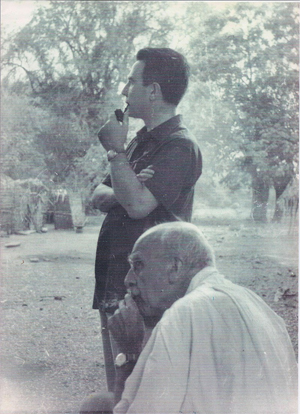 Marcello Siniscalco (standing) and Haldane in Andhra Pradesh, India, 1964
Marcello Siniscalco (standing) and Haldane in Andhra Pradesh, India, 1964 J. B. S. Haldane Avenue in Kolkata, the busy connecting road from Eastern Metropolitan Bypass to Park Circus area containing Science City
J. B. S. Haldane Avenue in Kolkata, the busy connecting road from Eastern Metropolitan Bypass to Park Circus area containing Science CityIn 1956, Haldane left University College London, and joined the Indian Statistical Institute (ISI) in Kolkata, India,[28] where he headed the biometry unit. Officially he stated that he left the UK because of the Suez Crisis, writing: "Finally, I am going to India because I consider that recent acts of the British Government have been violations of international law."
He believed that the warm climate would do him good, and that India shared his socialist dreams.[29] The university had sacked his wife Helen for excessive drinking and refusing to pay a fine, triggering Haldane's resignation. He declared he would no longer wear socks, "Sixty years in socks is enough."[30] and always dressed in Indian attire.[9]
He was keenly interested in inexpensive research.
He wrote to Julian Huxley about his observations on Vanellus malabaricus, the yellow-wattled lapwing. He advocated the use of Vigna sinensis (cowpea) as a model for studying plant genetics. He took an interest in the pollination of Lantana camara. He lamented that Indian universities forced those who took up biology to drop mathematics.[31] Haldane took an interest in the study of floral symmetry. In January 1961 he befriended Gary Botting, 1960 U.S. Science Fair winner in zoology (who had first visited the Haldanes along with Susan Brown, 1960 U.S. National Science Fair winner in botany), inviting him to share the results of his experiments hybridising Antheraea silk moths.
J.B.S., his wife Helen Spurway, and Krishna Dronamraju were present at the Oberoi Grand Hotel in Kolkata when Brown reminded the Haldanes that she and Botting had a previously scheduled event that would prevent them from accepting an invitation to a banquet proposed by J.B.S. and Helen in their honour and had regretfully declined the honour. After the two students had left the hotel, Haldane went on his much-publicized hunger strike to protest what he regarded as a "U.S. insult."[32][33] When the director of the ISI, P. C. Mahalanobis, confronted Haldane about both the hunger strike and the unbudgeted banquet, Haldane resigned from his post (in February 1961), and moved to a newly established biometry unit in Odisha.[29]
Haldane took Indian citizenship;[28] he was interested in Hinduism and became a vegetarian.[29] In 1961, Haldane described India as "the closest approximation to the Free World." Jerzy Neyman objected that "India has its fair share of scoundrels and a tremendous amount of poor unthinking and disgustingly subservient individuals who are not attractive."[28] Haldane retorted:
Perhaps one is freer to be a scoundrel in India than elsewhere. So one was in the U.S.A in the days of people like Jay Gould, when (in my opinion) there was more internal freedom in the U.S.A than there is today. The "disgusting subservience" of the others has its limits. The people of Calcutta riot, upset trams, and refuse to obey police regulations, in a manner which would have delighted Jefferson. I don't think their activities are very efficient, but that is not the question at issue.
When on 25 June 1962 he was described in print as a "Citizen of the World" by Groff Conklin, Haldane's response was as follows:[28]
No doubt I am in some sense a citizen of the world. But I believe with Thomas Jefferson that one of the chief duties of a citizen is to be a nuisance to the government of his state. As there is no world state, I cannot do this. On the other hand, I can be, and am, a nuisance to the government of India, which has the merit of permitting a good deal of criticism, though it reacts to it rather slowly. I also happen to be proud of being a citizen of India, which is a lot more diverse than Europe, let alone the U.S.A, the U.S.S.R or China, and thus a better model for a possible world organisation. It may of course break up, but it is a wonderful experiment. So, I want to be labeled as a citizen of India.
DeathShortly before his death from cancer, Haldane wrote a comic poem while in the hospital, mocking his own incurable disease. It was read by his friends, who appreciated the consistent irreverence with which Haldane had lived his life. The poem first appeared in print in 21 February 1964 issue of the New Statesman, and runs:[34][35]
Cancer's a Funny Thing:
I wish I had the voice of Homer
To sing of rectal carcinoma,
This kills a lot more chaps, in fact,
Than were bumped off when Troy was sacked ...
The poem ends:
... I know that cancer often kills,
But so do cars and sleeping pills;
And it can hurt one till one sweats,
So can bad teeth and unpaid debts.
A spot of laughter, I am sure,
Often accelerates one's cure;
So let us patients do our bit
To help the surgeons make us fit.
Haldane died on 1 December 1964 in Bhubaneswar. He willed that his body be used for medical research and teaching [36] at the Rangaraya Medical College, Kakinada.[37]
My body has been used for both purposes during my lifetime and after my death, whether I continue to exist or not, I shall have no further use for it, and desire that it shall be used by others. Its refrigeration, if this is possible, should be a first charge on my estate.[38]
Academic achievementsFollowing his father's footsteps, Haldane's first publication was on the mechanism of gaseous exchange by haemoglobin.[15] and subsequently worked on the chemical properties of blood as a pH buffer.[39][40] He investigated several aspects of kidney functions and mechanism of excretion.[41][42]
Enzyme kineticsIn 1925, with G. E. Briggs, Haldane derived a new interpretation of the enzyme kinetics law described by Victor Henri in 1903, different from the 1913 Michaelis–Menten equation. Leonor Michaelis and Maud Menten assumed that enzyme (catalyst) and substrate (reactant) are in fast equilibrium with their complex, which then dissociates to yield product and free enzyme. The Briggs–Haldane equation was of the same algebraic form; but their derivation is based on the quasi-steady state approximation, which is the concentration of intermediate complex (or complexes) does not change. As a result, the microscopic meaning of the "Michaelis Constant" (Km) is different. Although commonly referring to it as Michaelis–Menten kinetics, most of the current models typically use the Briggs–Haldane derivation.[43][44]
Genetic linkageWith his sister Naomi Mitchison, Haldane started investigating Mendelian genetics in 1908, used guinea pigs and mice, publishing Reduplication in mice in 1915[45] the first demonstration of genetic linkage in mammals, showing that certain genetic traits tend to be inherited together (as was later discovered, because of their proximity on chromosomes).[3] As the paper was written during Haldane's service in the First World War, James F. Crow called it "the most important science article ever written in a front-line trench".[46] He was the first to demonstrate linkage in chickens in 1921,[47] and (with Julia Bell) in humans in 1937.[48]
Haldane's principleIn his essay On Being the Right Size he outlines Haldane's principle, which states that the size very often defines what bodily equipment an animal must have: "Insects, being so small, do not have oxygen-carrying bloodstreams. What little oxygen their cells require can be absorbed by simple diffusion of air through their bodies. But being larger means an animal must have complicated oxygen pumping and distributing systems to reach all the cells." The conceptual metaphor to animal allometry has been of use in energy economics and secession ideas.[49][50]
Origin of lifeFurther information: Prebiotic soup
Haldane introduced the modern concept of abiogenesis in an eight-page article titled The origin of life, in the Rationalist Annual in 1929,[51] describing the primitive ocean as a "vast chemical laboratory" containing a mixture of inorganic compounds – like a "hot dilute soup" in which organic compounds could have formed. Under the solar energy the anoxic atmosphere containing carbon dioxide, ammonia and water vapour gave rise to a variety of organic compounds, "living or half-living things". The first molecules reacted with one another to produce more complex compounds, and ultimately the cellular components. At some point a kind of "oily film" was produced that enclosed self-replicating nucleic acids, thereby becoming the first cell. J. D. Bernal named the hypothesis biopoiesis or biopoesis, the process of living matter spontaneously evolving from self-replicating but lifeless molecules. Haldane further hypothesised that viruses were the intermediate entities between the prebiotic soup and the first cells. He asserted that prebiotic life would have been "in the virus stage for many millions of years before a suitable assemblage of elementary units was brought together in the first cell."[51] The idea was generally dismissed as "wild speculation".[52] Alexander Oparin had suggested a similar idea in Russian in 1924 (published in English in 1936). The gained some empirical support in 1953 with the classic Miller–Urey experiment. Since then, the primordial soup theory (Oparin–Haldane hypothesis) has become prevalent in the study of abiogenesis.[53][54][55]
Malaria and Sickle-Cell AnemiaIn 1949, Haldane proposed that genetic disorders in humans living in malaria-endemic regions provided a phenotype with immunity to blood-borne haemophiles. He noted that mutations expressed in red blood cells, such as sickle-cell anemia and various thalassemias, were prevalent only in tropical regions where malaria has been endemic. He further observed that these were favourable traits for natural selection which protected individuals from receiving malarial infection.[56] This idea was eventually confirmed by Anthony C. Allison in 1954.[57][58]
Population geneticsFurther information: Modern synthesis (20th century)
He was one of the three major figures to develop the mathematical theory of population genetics, along with Ronald Fisher and Sewall Wright. He thus played an important role in the modern evolutionary synthesis of the early 20th century. He re-established natural selection as the central mechanism of evolution by explaining it as a mathematical consequence of Mendelian inheritance.[59][60] He wrote a series of ten papers, A Mathematical Theory of Natural and Artificial Selection, deriving expressions for the direction and rate of change of gene frequencies, and also analyzing the interaction of natural selection with mutation and migration. Haldane's book, The Causes of Evolution (1932), summarised these results, especially in its extensive appendix.
His contributions to statistical human genetics included: the first methods using maximum likelihood for the estimation of human linkage maps; pioneering methods for estimating human mutation rates; the first estimates of mutation rate in humans (2 × 10−5 mutations per gene per generation for the X-linked haemophilia gene); and the first notion that there is a "cost of natural selection".[61] At the John Innes Horticultural Institution, he developed the complicated linkage theory for polyploids;[22] and extended the idea of gene/enzyme relationships with the biochemical and genetic study of plant pigments.
Political views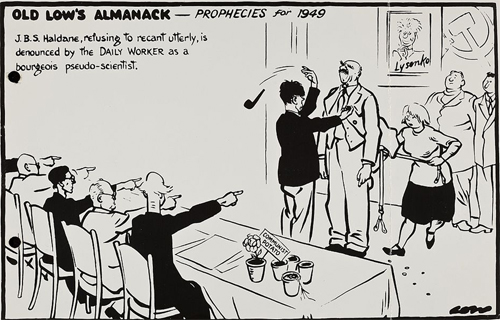 A Low cartoon featuring Haldane – "Prophesies for 1949"
A Low cartoon featuring Haldane – "Prophesies for 1949"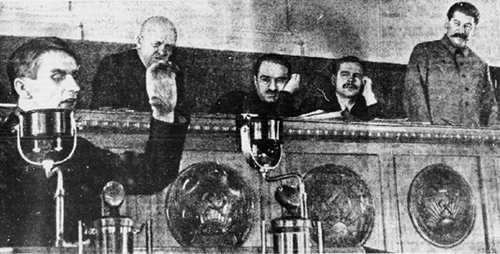 Lysenko speaking at the Kremlin in 1935. Behind him are (left to right) Stanislav Kosior, Anastas Mikoyan, Andrei Andreev and Joseph Stalin.Haldane became a socialist during the First World War; supported the Second Spanish Republic during the Spanish Civil War; and then became an open supporter of the Communist Party in 1937. A pragmatic dialectical-materialist Marxist, he wrote many articles for the Daily Worker.
Lysenko speaking at the Kremlin in 1935. Behind him are (left to right) Stanislav Kosior, Anastas Mikoyan, Andrei Andreev and Joseph Stalin.Haldane became a socialist during the First World War; supported the Second Spanish Republic during the Spanish Civil War; and then became an open supporter of the Communist Party in 1937. A pragmatic dialectical-materialist Marxist, he wrote many articles for the Daily Worker. In On Being the Right Size, he wrote: "while nationalization of certain industries is an obvious possibility in the largest of states, I find it no easier to picture a completely socialized British Empire or United States than an elephant turning somersaults or a hippopotamus jumping a hedge."
Haldane has been accused by authors including Peter Wright and Chapman Pincher to have been a Soviet GRU spy codenamed Intelligentsia.[62][63]
Main Intelligence Directorate (Russian: Гла́вное разве́дывательное управле́ние, tr. Glavnoye razvedyvatel'noye upravleniye, IPA: [ˈglavnəjə rɐzˈvʲɛdɨvətʲɪlʲnəjə ʊprɐˈvlʲenʲɪjə]), abbreviated GRU (Russian: ГРУ, IPA: [geeˈru]), was the foreign military intelligence agency of the Soviet Army General Staff of the Soviet Union until 1991 and for a brief few months the foreign military intelligence agency of the newly established Russian Federation until it was deactivated on 7 May 1992 and replaced with the G.U. on the same day.
-- Main Intelligence Directorate (GRU), by Wikipedia
In 1938, he proclaimed enthusiastically that "I think that Marxism is true." He joined the Communist Party of Great Britain in 1942. He was pressed to speak out about the rise of Lysenkoism and the persecution of geneticists in the Soviet Union as anti-Darwinist and the political suppression of genetics as incompatible with dialectical materialism. He shifted his polemic focus to the United Kingdom, criticizing the dependence of scientific research on financial patronage. In 1941 he wrote about the Soviet trial of his friend and fellow geneticist Nikolai Vavilov:The controversy among Soviet geneticists has been largely one between the academic scientist, represented by Vavilov and interested primarily in the collection of facts, and the man who wants results, represented by Lysenko. It has been conducted not with venom, but in a friendly spirit. Lysenko said (in the October discussions of 1939): 'The important thing is not to dispute; let us work in a friendly manner on a plan elaborated scientifically. Let us take up definite problems, receive assignments from the People's Commissariat of Agriculture of the USSR and fulfil them scientifically. Soviet genetics, as a whole, is a successful attempt at synthesis of these two contrasted points of view.'
By the end of the Second World War Haldane had become an explicit critic of the regime.
He left the party in 1950, shortly after considering standing for Parliament as a Communist Party candidate. He continued to admire Joseph Stalin, describing him in 1962 as "a very great man who did a very good job".[20]Social and scientific views
Human cloningHaldane was the first to have thought of the genetic basis for human cloning, and the eventual artificial breeding of superior individuals. For this he introduced the terms "clone" and "cloning",[64] modifying the earlier "clon" which had been used in agriculture since the early 20th century (from Greek klōn, twig).
He introduced the term in his speech on "Biological Possibilities for the Human Species of the Next Ten Thousand Years" at the Ciba Foundation Symposium on Man and his Future in 1963. He said:[65]
It is extremely hopeful that some human cell lines can be grown on a medium of precisely known chemical composition. Perhaps the first step will be the production of a clone from a single fertilized egg, as in
Brave New World...
On the general principle that men will make all possible mistakes before choosing the right path, we shall no doubt clone the wrong people [like Hitler]...
Assuming that cloning is possible, I expect that most clones would be made from people aged at least fifty, except for athletes
and dancers, who would be cloned younger. They would be made from people who were held to have excelled in a socially acceptable accomplishment.
Ectogenesis and in vitro fertilisationHis essay Daedalus; or, Science and the Future (1924) introduced the term ectogenesis for the concept of what is later known as in vitro fertilisation (test tube babies).
He envisioned ectogenesis as a tool for creating better individuals (eugenics).[66] Haldane's work was an influence on Huxley's Brave New World (1932) and was also admired by Gerald Heard.[67] Various essays on science were collected and published in a volume titled Possible Worlds in 1927. His book, A.R.P. (Air Raid Precautions) (1938) combined his physiological research into the effects of stress upon the human body with his experience of air raids during the Spanish Civil War to provide a scientific account of the likely effects of the air raids that Britain was to endure during the Second World War.
Criticism of C.S. LewisAlong with Olaf Stapledon, Charles Kay Ogden, I. A. Richards, and
H. G. Wells,
Haldane was accused by C. S. Lewis of scientism. Haldane criticised Lewis and his Ransom Trilogy for the "complete mischaracterisation of science, and his disparagement of the human race".[68] He wrote a book for children titled My Friend Mr Leakey (1937), containing the stories "A Meal With a Magician", "A Day in the Life of a Magician", "Mr Leakey's Party", "Rats", "The Snake with the Golden Teeth", and "My Magic Collar Stud"; later editions featured illustrations by Quentin Blake.
Hydrogen-generating windmillsIn 1923, in a talk given in Cambridge titled "Science and the Future", Haldane, foreseeing the exhaustion of coal for power generation in Britain, proposed a network of hydrogen-generating windmills. This is the first proposal of the hydrogen-based renewable energy economy.[69][70][71]
ScientistsIn his An Autobiography in Brief, published shortly before his death in India, Haldane named four close associates as showing promise to become illustrious scientists: T. A. Davis, Dronamraju Krishna Rao, Suresh Jayakar and S. K. Roy.[72]
Awards and honoursHaldane was elected a Fellow of the Royal Society in 1932.[23] The French Government conferred him its National Order of the Legion of Honour in 1937. In 1952, he received the Darwin Medal from the Royal Society. In 1956, he was awarded the Huxley Memorial Medal of the Anthropological Institute of Great Britain. He received the Feltrinelli Prize from Accademia Nazionale dei Lincei in 1961. He also received an Honorary Doctorate of Science, an Honorary Fellowship at New College, and the Kimber Award of the US National Academy of Sciences. He was awarded the Linnean Society of London's prestigious Darwin–Wallace Medal in 1958.[37]
LegacyThe Haldane Lecture at the John Innes Centre,[73] where Haldane worked from 1927 to 1937 is named in his honour.[74] The JBS Haldane Lecture[75] of The Genetics Society is also named in his honour.
Haldane was parodied as "the biologist too absorbed in his experiments to notice his friends bedding his wife" by his friend Aldous Huxley in the novel Antic Hay (1923). Biography on him was published as A Dominant Character in 2019.
Quotations 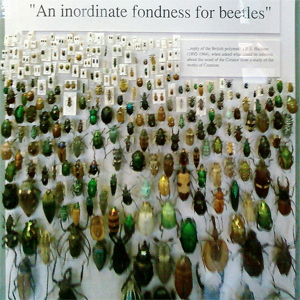 Oxford University Museum of Natural History display dedicated to Haldane and his reply when asked to comment on the mind of the Creator.
Oxford University Museum of Natural History display dedicated to Haldane and his reply when asked to comment on the mind of the Creator.• He is famous for the (possibly apocryphal) response that he gave when some theologians asked him what could be inferred about the mind of the Creator from the works of His Creation: "An inordinate fondness for beetles."[76][77] This is in reference to there being over 400,000 known species of beetles in the world, and that this represents 40% of all known insect species (at the time of the statement, it was over half of all known insect species).[78]
• He was often quoted as saying, "My own suspicion is that the universe is not only queerer than we suppose, but queerer than we can suppose."[79]
• "It seems to me immensely unlikely that mind is a mere by-product of matter. For if my mental processes are determined wholly by the motions of atoms in my brain I have no reason to suppose that my beliefs are true. They may be sound chemically, but that does not make them sound logically. And hence I have no reason for supposing my brain to be composed of atoms."[79]:209
• "Teleology is like a mistress to a biologist: he cannot live without her but he's unwilling to be seen with her in public."[80][81]
• "I had gastritis for about fifteen years until I read Lenin and other writers, who showed me what was wrong with our society and how to cure it. Since then I have needed no magnesia."[82]
• "I suppose the process of acceptance will pass through the usual four stages: (i) This is worthless nonsense; (ii) This is an interesting, but perverse, point of view; (iii) This is true, but quite unimportant; (iv) I always said so."[83]
• "Three hundred and ten species in all of India, representing two hundred and thirty-eight genera, sixty-two families, nineteen different orders. All of them on the Ark. And this is only India, and only the birds."[84]
• "The stupidity of the mynah shows that in birds, as in men, linguistic and practical abilities are not very highly correlated. A student who can repeat a page of a text book may get first class honours, but may be incapable of doing research."[85]
• When asked whether he would lay down his life for his brother, Haldane, presaging Hamilton's rule, supposedly replied "two brothers or eight cousins".[86]
Publications• Daedalus; or, Science and the Future (1924), E. P. Dutton and Company, Inc., a paper read to the Heretics, Cambridge, on 4 February 1923
o second edition (1928), London: Kegan Paul, Trench & Co.
o see also Haldane's Daedalus Revisited (1995), ed. with an introd. by Krishna R. Dronamraju, Foreword by Joshua Lederberg; with essays by M. F. Perutz, Freeman Dyson, Yaron Ezrahi, Ernst Mayr, Elof Axel Carlson, D. J. Weatherall, N. A. Mitchison and the editor. Oxford University Press. ISBN 0-19-854846-X
• A Mathematical Theory of Natural and Artificial Selection, a series of papers beginning in 1924
• Briggs, G. E; Haldane, J. B (1925). "A note on the kinetics of enzyme action". Biochemical Journal. 19 (2): 338–339. doi:10.1042/bj0190338. PMC 1259181. PMID 16743508. (With G.E. Briggs)
• Callinicus: A Defence of Chemical Warfare (1925), E. P. Dutton
• Possible Worlds and Other Essays (1927), Chatto & Windus; 2001 reprint, Transaction Publishers: ISBN 0-7658-0715-7 (includes "On Being the Right Size" and "On Being One's Own Rabbit")
• On Being the Right Size (1929)
• "The origin of life" in the Rationalist Annual (1929)
• Animal Biology (1929) Oxford: Clarendon
• The Sciences and Philosophy (1929) NY: Doubleday, Doran and Company. By John Scott Haldane, JBS Haldane's father.
• Enzymes (1930), MIT Press 1965 edition with new preface by the author written just prior to his death: ISBN 0-262-58003-9
• Haldane, J. B (1931). "Mathematical Darwinism: A discussion of the genetical theory of natural selection". The Eugenics Review. 23 (2): 115–117. PMC 2985031. PMID 21259979.
• The Inequality of Man, and Other Essays (1932)
• The Causes of Evolution (1932)
• Science and Human Life (1933), Harper and Brothers, Ayer Co. reprint: ISBN 0-8369-2161-5
• Science and the Supernatural: Correspondence with Arnold Lunn (1935), Sheed & Ward, Inc,
• Fact and Faith (1934), Watts Thinker's Library[87]
• Human Biology and Politics (1934)
• "A Contribution to the Theory of Price Fluctuations", The Review of Economic Studies, 1:3, 186–195 (1934).
• My Friend Mr Leakey (1937), Jane Nissen Books reprint (2004): ISBN 978-1-903252-19-2
• "A Dialectical Account of Evolution" in Science & Society Volume I (1937)
• Haldane, J. B (1937). "View on race and eugenics: propaganda or science?". The Eugenics Review. 28 (4): 333–334. PMC 2985639. PMID 21260239.
• Bell, J; Haldane, J. B (1937). "The Linkage between the Genes for Colour-blindness and Haemophilia in Man". Annals of Human Genetics. 50 (1): 3–34. Bibcode:1937RSPSB.123..119B. doi:10.1111/j.1469-1809.1986.tb01935.x. PMID 3322165. (with Julia Bell)
• Haldane, J. B; Smith, C. A (1947). "A new estimate of the linkage between the genes for colourblindness and haemophilia in man". Annals of Eugenics. 14 (1): 10–31. doi:10.1111/j.1469-1809.1947.tb02374.x. PMID 18897933. (with C.A.B. Smith)
• Air Raid Precautions (A.R.P.) (1938), Victor Gollancz
• Heredity and Politics (1938), Allen and Unwin.
• "Reply to A.P. Lerner's Is Professor Haldane's Account of Evolution Dialectical?" in Science & Society volume 2 (1938)
• The Marxist Philosophy and the Sciences (1939), Random House, Ayer Co. reprint: ISBN 0-8369-1137-7
• Preface to Engels' Dialectics of Nature (1939)
• Science and Everyday Life (1940), Macmillan, 1941 Penguin, Ayer Co. 1975 reprint: ISBN 0-405-06595-7
• "Lysenko and Genetics" in Science & Society volume 4 (1940)
• "Why I am a Materialist" in Rationalist Annual (1940)
• "The Laws of Nature" in Rationalist Annual (1940)
• Science in Peace and War (1941), Lawrence & Wishart Ltd
• New Paths in Genetics (1941), George Allen & Unwin
• Heredity & Politics (1943), George Allen & Unwin
• Why Professional Workers should be Communists (1945), London: Communist Party (of Great Britain) In this four page pamphlet, Haldane contends that Communism should appeal to professionals because Marxism is based on the scientific method and Communists hold scientists as important; Haldane subsequently disavowed this position.
• Adventures of a Biologist (1947)
• Science Advances (1947), Macmillan
• What is Life? (1947), Boni and Gaer, 1949 edition: Lindsay Drummond
• Everything Has a History (1951), Allen & Unwin—Includes "Auld Hornie, F.R.S."; C.S. Lewis's "Reply to Professor Haldane" is available in "On Stories and Other Essays on Literature," ed. Walter Hooper (1982), ISBN 0-15-602768-2.
• "The Origins of Life", New Biology, 16, 12–27 (1954). Suggests that an alternative biochemistry could be based on liquid ammonia.
• The Biochemistry of Genetics (1954)
• Haldane, J. B (1955). "Origin of Man". Nature. 176 (4473): 169–170. Bibcode:1955Natur.176..169H. doi:10.1038/176169a0. PMID 13244650.
• Haldane, J. B. S (1957). "The cost of natural selection". Journal of Genetics. 55 (3): 511–524. doi:10.1007/BF02984069.
• Haldane, J. B (1956). "Natural selection in man". Acta Genetica et Statistica Medica. 6 (3): 321–332. doi:10.1159/000150849. PMID 13434715.
• Little Science, Big Science (1961)
• "Cancer's a Funny Thing", in New Statesman, 21 February 1964.
See also• Experiments in the Revival of Organisms, a 1940 Soviet film featuring Haldane in the introduction.
• List of independent discoveries ("primordial soup" theory of the evolution of life from carbon-based molecules, c. 1924)
• Precambrian rabbit
• Timeline of hydrogen technologies
• Biography portal
• India portal
• Mathematics portal
• Science portal
• United Kingdom portal
References1. Pirie, N. W. (1966). "John Burdon Sanderson Haldane. 1892–1964". Biographical Memoirs of Fellows of the Royal Society. 12: 218–249. doi:10.1098/rsbm.1966.0010.
2. Rao, Veena (2015). J B S Haldane, an Indian scientist of British origin. Current Science 109 (3): 634-638.
3. Dronamraju, Krishna R (2012). "Recollections of J.B.S. Haldane, with special reference to Human Genetics in India". Indian Journal of Human Genetics. 18 (1): 3–8. doi:10.4103/0971-6866.96634. PMC 3385175. PMID 22754215.
4. New research in this field began in 2018 in Canada, cf.
https://nationalpost.com/news/canada/on ... imulator-2 .
5. Turelli, M; Orr, HA (1995). "The dominance theory of Haldane's rule". Genetics. 140 (1): 389–402. PMC 1206564. PMID 7635302.
6. Haldane, J. B. S. (1922). "Sex ratio and unisexual sterility in hybrid animals". Journal of Genetics. 12 (2): 101–109. doi:10.1007/BF02983075.
7. Yount, Lisa (2003). A to Z of Biologists. New York, NY: Facts on File, Inc. pp. 113–115. ISBN 978-1-4381-0917-6. Archived from the original on 7 March 2017.
8. Clarke, Arthur C. (2009). "Foreword". In John Burdon Sanderson Haldane (ed.). What I Require From Life: Writings on Science and Life from J.B.S. Haldane. Oxford: Oxford University Press. p. ix. ISBN 978-0-19-923770-8. Archived from the original on 8 March 2017.
9. Dronamraju, KR (1992). "J.B.S. Haldane (1892–1964): centennial appreciation of a polymath". American Journal of Human Genetics. 51 (4): 885–9. PMC 1682816. PMID 1415229.
10. Gould, Stephen Jay (2011). The Lying Stones of Marrakech : Penultimate Reflections in Natural History (1st Harvard University Press ed.). Cambridge, Mass.: Belknap Press of Harvard University Press. p. 305. ISBN 978-0-674-06167-5.
11. Adams, Mark B. (2000). "Last judgment: the visionary biology of J.B.S. Haldane". Journal of the History of Biology. 33 (3): 457–491. doi:10.1023/A:1004891323595. JSTOR 4331611. PMID 13678078.
12. Acott, C. (1999). "JS Haldane, JBS Haldane, L Hill, and A Siebe: A brief resumé of their lives". South Pacific Underwater Medicine Society Journal. 29 (3). ISSN 0813-1988. OCLC 16986801. Archived from the original on 27 July 2011. Retrieved 12 July 2008.
13. Hedrick, Larry (1989). "J.B.S. Haldane: A Legacy in Several Worlds". The World & I Online. Archived from the original on 22 February 2014. Retrieved 17 February 2014.
14. "J. S. Haldane (1860–1936)". Oxfordshire Blue Plaques Board. Archived from the original on 22 February 2014. Retrieved 17 February 2014.
15. Douglas, CG; Haldane, JS; Haldane, JB (1912). "The laws of combination of haemoglobin with carbon monoxide and oxygen". The Journal of Physiology. 44 (4): 275–304. doi:10.1113/jphysiol.1912.sp001517. PMC 1512793. PMID 16993128.
16. "No. 29172". The London Gazette (Supplement). 25 May 1915. p. 5081.
17. "No. 29172". The London Gazette (Supplement). 25 May 1915. p. 5079.
18. "No. 29399". The London Gazette (Supplement). 10 December 1915. p. 12410.
19. "No. 32445". The London Gazette (Supplement). 2 September 1921. p. 7036.
20. Cochran, Gregory; Harpending, Henry (10 January 2009). "J.B.S. Haldane". The 10,000 Year Explosion. Archivedfrom the original on 9 June 2016. Retrieved 5 May 2016.
21. "Biological Sciences". New College, Oxford. Archived from the original on 25 April 2016. Retrieved 15 April 2016.
22. "John Burdon Sanderson Haldane (1892–1964): Biochemist and geneticist; head of genetics at JIHI, 1927–1937. FRS 1932". jic.ac.uk. Archived from the original on 4 March 2016.
23. "Full view of record [of Haldane]". UCL Archives. University College London. Archived from the original on 2 March 2017. Retrieved 3 February 2017.
24. GRO marriage register Dec 1945 Pancras
25. Jobling MA (2012). "The unexpected always happens". Investigative Genetics. 3 (1): 5. doi:10.1186/2041-2223-3-5. PMC 3298498. PMID 22357349.
26. J. B. S. Haldane. Stephen Jay Gould Collection, ID: Q171 .H1565 1947. Palo Alto, California: Stanford Library, Stanford University.
27. Bryson, Bill. "A Short History Of Nearly Everything". 1st. New York: Broadway Books, 2003. at Googlebooks Archived 7 March 2017 at the Wayback Machine
28. India After Gandhi: The History of the World's Largest Democracy, Ramachandra Guha, Pan Macmillan, 2008, pp. 769–770
29. Krishna R. Dronamraju (1987). "On Some Aspects of the Life and Work of John Burdon Sanderson Haldane, F.R.S., in India". Notes and Records of the Royal Society of London. 41 (2): 211–237. doi:10.1098/rsnr.1987.0006. JSTOR 531546. PMID 11622022.
30. deJong-Lambert, William (2012). The Cold War Politics of Genetic Research: An Introduction to the Lysenko Affair (2012. ed.). Dordrecht: Springer. p. 150. ISBN 978-94-007-2839-4. Archived from the original on 8 March 2017.
31. Majumder PP (1998). "Haldane's Contributions to Biological Research in India" (PDF). Resonance. 3 (12): 32–35. doi:10.1007/BF02838095. Archived (PDF) from the original on 10 September 2008.
32. "Haldane on Fast: Insult by USIS Alleged," Times of India, 19 January 1961; "Protest Fast by Haldane: USIS's "Anti-Indian Activities," Times of India, 18 January 1961; "Situation was Misunderstood, Scholars Explain," Times of India, 20 January 1961; "USIS Explanation does not satisfy Haldane: Protest fast continues," Times of India, 18 January 1961; "USIS Claim Rejected by Haldane: Protest Fast to Continue," Times of India, 18 January 1961; "Haldane Not Satisfied with USIS Apology: Fast to Continue," Free Press Journal, 18 January 1961; "Haldane Goes on Fast In Protest Against U.S. Attitude," Times of India, 18 January 1961; "Haldane to continue fast: USIS explanation unsatisfactory," Times of India, 19 January 1961; "Local boy in hunger strike row," Toronto Star, 20 January 1961; "Haldane, Still on Fast, Loses Weight: U.S.I.S. Act Termed 'Discourteous'," Indian Express, 20 January 1961; "Haldane Slightly Tired on Third Day of Fast," Times of India, 21 January 1961; "Haldane Fasts for Fourth Consecutive Day," Globe and Mail, 22 January 1961
33. Botting, Gary (1984). "Preface". In Heather Denise Harden; Gary Botting (eds.). The Orwellian World of Jehovah's Witnesses. Toronto: University of Toronto Press. p. xvii. ISBN 978-0-8020-6545-2. Archived from the original on 12 March 2017.
34. Dronamraju, K. (2010). "J. B. S. Haldane's last years: his life and work in India (1957–1964)". Genetics. 185 (1): 5–10. doi:10.1534/genetics.110.116632. PMC 2870975. PMID 20516291.
35. Hesketh, Robin (2012). Betrayed by Nature: The War on Cancer. New York (US): Palgrave Macmillan. pp. 237–238. ISBN 978-0-230-34192-0.
36. Clark, Ronald (1969). The Life and Work of J.B.S. Haldane. New York, Coward-McCann. Retrieved 29 June 2019.
37. Mahanti, Subodh. "John Burdon Sanderson Haldane: The Ideal of a Polymath". Vigyan Prasar Science Portal. Archived from the original on 14 April 2013. Retrieved 19 February 2014.
38. Murty, K. Krishna (2005). Spice in science. Dehli: Pustak Mahal. p. 68. ISBN 978-81-223-0900-3. Archived from the original on 21 September 2014. Retrieved 1 February 2011.
39. Davies, HW; Haldane, JB; Kennaway, EL (1920). "Experiments on the regulation of the blood's alkalinity: I". The Journal of Physiology. 54 (1–2): 32–45. doi:10.1113/jphysiol.1920.sp001906. PMC 1405746. PMID 16993473.
40. Haldane, JB (1921). "Experiments on the regulation of the blood's alkalinity: II". The Journal of Physiology. 55 (3–4): 265–75. doi:10.1113/jphysiol.1921.sp001969. PMC 1405425. PMID 16993510.
41. Baird, MM; Haldane, JB (1922). "Salt and water elimination in man". The Journal of Physiology. 56 (3–4): 259–62. doi:10.1113/jphysiol.1922.sp002007. PMC 1405382. PMID 16993567.
42. Davies, HW; Haldane, JB; Peskett, GL (1922). "The excretion of chlorides and bicarbonates by the human kidney". The Journal of Physiology. 56 (5): 269–74. doi:10.1113/jphysiol.1922.sp002009. PMC 1405381. PMID 16993528.
43. Briggs, GE; Haldane, JB (1925). "A Note on the Kinetics of Enzyme Action". The Biochemical Journal. 19 (2): 338–9. doi:10.1042/bj0190338. PMC 1259181. PMID 16743508.
44. Chen, W. W.; Niepel, M.; Sorger, P. K. (2010). "Classic and contemporary approaches to modeling biochemical reactions". Genes & Development. 24 (17): 1861–1875. doi:10.1101/gad.1945410. PMC 2932968. PMID 20810646.
45. Haldane, J. B. S.; Sprunt, A. D.; Haldane, N. M. (1915). "Reduplication in mice (Preliminary Communication)". Journal of Genetics. 5 (2): 133–135. doi:10.1007/BF02985370. Archived from the original on 18 October 2016.
46. Crow, JF (1992). "Centennial: J. B. S. Haldane, 1892–1964". Genetics. 130 (1): 1–6. PMC 1204784. PMID 1732155.
47. Haldane, JB (1921). "Linkage in poultry". Science. 54 (1409): 663. Bibcode:1921Sci....54..663H. doi:10.1126/science.54.1409.663. PMID 17816160.
48. Bell, J.; Haldane, J. B. S. (1937). "The Linkage between the Genes for Colour-Blindness and Haemophilia in Man". Proceedings of the Royal Society B: Biological Sciences. 123 (831): 119–150. Bibcode:1937RSPSB.123..119B. doi:10.1098/rspb.1937.0046.
49. Marvin, Stephen (2012). Dictionary of Scientific Principles. Chicester: John Wiley & Sons. p. 140. ISBN 978-1-118-58224-4.
50. Putting science and engineering at the heart of Government policy : eighth report of session 2008–09. 1. London: The Stationery Office: Great Britain: Parliament: House of Commons: Innovation, Universities, Science and Skills Committee. 2009. p. 40. ISBN 978-0-215-54034-8.
51. Lazcano, A. (2010). "Historical development of origins research". Cold Spring Harbor Perspectives in Biology. 2 (11): a002089. doi:10.1101/cshperspect.a002089. PMC 2964185. PMID 20534710.
52. Fry, Iris (2000). The Emergence of Life on Earth: A Historical and Scientific Overview. New Brunswick, N.J.: Rutgers University Press. pp. 65–66, 71–74. ISBN 978-0-8135-2740-6.
53. Gordon-Smith, Chris. "The Oparin–Haldane Hypothesis". Archived from the original on 26 February 2014. Retrieved 18 February 2014.
54. "The Oparin–Haldane Theory of the Origin of Life". Department of Chemistry, University of Oxford. Archived from the original on 23 September 2015. Retrieved 18 February 2014.
55. Lazcano, A. (2010). "Historical development of origins research". Cold Spring Harbor Perspectives in Biology. 2 (11): a002089. doi:10.1101/cshperspect.a002089. PMC 2964185. PMID 20534710.
56. Sabeti, Pardis C (2008). "Natural selection: uncovering mechanisms of evolutionary adaptation to infectious disease". Nature Education. 1 (1): 13. Archived from the original on 9 January 2015.
57. Allison, AC (1954). "The distribution of the sickle-cell trait in East Africa and elsewhere, and its apparent relationship to the incidence of subtertian malaria". Transactions of the Royal Society of Tropical Medicine and Hygiene. 48 (4): 312–8. doi:10.1016/0035-9203(54)90101-7. PMID 13187561.
58. Hedrick, Philip W (2012). "Resistance to malaria in humans: the impact of strong, recent selection". Malaria Journal. 11 (1): 349. doi:10.1186/1475-2875-11-349. PMC 3502258. PMID 23088866.
59. Haldane, JB (1990). "A mathematical theory of natural and artificial selection--I. 1924". Bulletin of Mathematical Biology. 52(1–2): 209–40, discussion 201–7. doi:10.1007/BF02459574. PMID 2185859.
60. Haldane, JB (1959). "The theory of natural selection today". Nature. 183 (4663): 710–3. Bibcode:1959Natur.183..710H. doi:10.1038/183710a0. PMID 13644170.
61. Haldane, J. B. S. (1935). "The rate of spontaneous mutation of a human gene". Journal of Genetics. 31 (3): 317–326. doi:10.1007/BF02982403.
62. Wright, Peter (1987). Spycatcher. Heinemann. p. 236.
63. Pincher, Chapman (2011). Treachery: Betrayals, Blunders and Cover-Ups: Six Decades of Espionage. Mainstream. p. 52. ISBN 978-1-84596-811-3. Archived from the original on 11 November 2017.
64. Thomas, Isabel (2013). Should scientists pursue cloning?. London: Raintree. p. 5. ISBN 978-1-4062-3391-9.
65. Haldane, J.B.S. (1963). "Biological Possibilities for the Human Species in the Next Ten Thousand Years". In Wolstenholme, Gordon (ed.). Man and his future. Novartis Foundation Symposia. London: J. & A. Churchill. pp. 337–361. doi:10.1002/9780470715291.ch22. ISBN 9780470714799. Archived from the original on 8 November 2014.
66. James, David N. (1987). "Ectogenesis: a reply to Singer and Wells". Bioethics. 1 (1): 80–99. doi:10.1111/j.1467-8519.1987.tb00006.x. PMID 11649763.
67. "Mr. Wells' Apocalypse" by Gerald Heard. The Nineteenth Century, October 1933. Reprinted in The H. G. Wells Scrapbook by Peter Haining. London : New English Library, 1978. ISBN 0-450-03778-9 (pp. 108–114).
68. Adams, Mark B., "The Quest for Immortality: Visions and Presentiments in Science and Literature", in Post, Stephen G., and Binstock, Robert H., The Fountain of Youth: Cultural, Scientific, and Ethical Perspectives on a Biomedical Goal. Oxford University Press, 2004; ISBN 0-19-517008-3 (p. 57–58).
69. "An Early Vision of Transhumanism, and the First Proposal of a Hydrogen-Based Renewable Energy Economy". Jeremy Norman & Co., Inc. Retrieved 19 February 2014.
70. Hordeski, Michael Frank (2009). Hydrogen & Fuel Cells: Advances in Transportation and Power. Lilburn, GA: The Fairmont Press, Inc. pp. 202–203. ISBN 978-0-88173-562-8. Archived from the original on 8 March 2017.
71. Demirbas, Ayhan (2009). Biohydrogen For Future Engine Fuel Demands (Online-Ausg. ed.). London: Springer London. p. 106. ISBN 978-1-84882-511-6. Archived from the original on 7 March 2017.
72. "Selected Genetic Papers of JBS Haldane", pp. 19–24, New York: Garland, 1990
73. Sponge, Creative. "The Haldane Lecture - John Innes Centre".
http://www.jic.ac.uk.
74. Wilmot, Sarah (2017). "J. B. S. Haldane: the John Innes years". Journal of Genetics. 96 (5): 815–826. doi:10.1007/s12041-017-0830-7. ISSN 0022-1333. PMID 29237891.
75. "JBS Haldane Lecture - Genetics Society".
76. Hutchinson, G. Evelyn (1959). "Homage to Santa Rosalia or Why Are There So Many Kinds of Animals?". The American Naturalist. 93 (870): 145–159. doi:10.1086/282070. JSTOR 2458768.
77. Cain, A.J. (1993). "[no title cited]". The Linnean. The Linnean Society of London. 9 (1).
78. Stork, Nigel E. (June 1993). "How many species are there?" (PDF). Biodiversity and Conservation. 2 (3): 215–232. doi:10.1007/BF00056669. hdl:10862/2512. ISSN 0960-3115. Archived from the original (PDF) on 13 April 2012. Retrieved 25 February 2011.
79. Haldane, J.B.S. (1932) [1927]. Possible Worlds, and Other Essays (reprint ed.). London, UK: Chatto and Windus.:286Emphasis in the original.
80. Hull, D. (1973). Philosophy of Biological Science. Foundations of Philosophy Series. Englewood Cliffs, N.J.: Prentice–Hall.
81. Mayr, Ernst (1974). Boston Studies in the Philosophy of Science. XIV. pp. 91–117.
82. Haldane, J.B.S. (1985). Smith, John Maynard (ed.). On being the right size and other essays. Oxford: Oxford University Press. p. 151. ISBN 978-0-19-286045-3 – via Google Books.
83. Haldane, J.B.S. (1963). "The Truth about Death: The Chester Beatty Research Institute Serially Abridged Life Tables, England and Wales, 1841–1960" (PDF). Book review. Journal of Genetics. 58 (3): 464. doi:10.1007/bf02986312. Archived (PDF)from the original on 22 February 2014.
84. Botting, Gary (1984). "Preface". The Orwellian World of Jehovah's Witnesses. p. xvi.
85. Majumder, Partha P. (1 February 2016). "A Humanitarian and a Great Indian". Genome Biology and Evolution. 8 (2): 467–469. doi:10.1093/gbe/evw012. ISSN 1759-6653. PMC 4779617. PMID 26837547.
86. Dugatkin, L.A. (2007). "Inclusive fitness theory from Darwin to Hamilton". Genetics. 176 (3): 1375–80. PMC 1931543. PMID 17641209. Archived from the original on 24 March 2015.
87. "Fact and faith". worldcatlibraries.org. Archived from the original on 29 September 2007.
Further reading• Bryson, Bill (2003). A Short History of Nearly Everything. pp. 300–302; ISBN 0-552-99704-8
• Clark, Ronald (1968). JBS: The Life and Work of J.B.S. Haldane. Coward-McCann. ISBN 0-340-04444-6
• Crow, James F. (2000). "Centennial: J. B. S. Haldane, 1892–1964". In Crow, James F.; Dove, William F. (eds.). Perspectives on Genetics: Anecdotal, Historical, and Critical Commentaries, 1987–1998. Madison (US): University of Wisconsin Press. pp. 253–258. ISBN 978-0-299-16604-5.
• Dronamraju, Krishna R. (1968). Haldane and Modern Biology. Johns Hopkins University Press. p. 352. ISBN 978-0-8018-0177-8.
• Dronamraju, Krishna R. (1985). Haldane : the Life and Work of J.B.S. Haldane with Special Reference to India. Aberdeen: Aberdeen University Press. ISBN 978-0-08-032436-4. Foreword by Naomi Mitchison.
• Dronamraju, Krishna (2011). Haldane, Mayr, and Beanbag Genetics. New York: Oxford University Press. p. 296. ISBN 978-0-19-981334-6.
• Dronamraju, Krishna R. (2015). Selected Genetic Papers of J.B.S. Haldane. Routledge. ISBN 978-1-138-78343-0.
• Haldane, Louisa Kathleen (2009) [1961]. Friends and Kindred: Memoirs. Glasgow: Kennedy & Boyd. p. 248. ISBN 978-1-904999-99-7.
• Tredoux, Gavan (2017). Comrade Haldane is too busy to go on holiday: JBS Haldane, communism and espionage. renoster.com.
External links• Media from Wikimedia Commons
• Quotations from Wikiquote
• Data from Wikidata
• Works by J.B.S. Haldane at Faded Page (Canada)
• Possible worlds, and other essays at Toronto Public Library
• Facsimiles of Haldane's books and some of his scientific papers, with photographs, a detailed bibliography of his publications and other materials.
• An online copy of Daedalus or Science and the Future
• A review (from a modern perspective) of The Causes of Evolution
• Unofficial SJG Archive – People – JBS Haldane (1892–1964)
• Haldane's contributions to science in India
• Marxist Writers: J.B.S. Haldane
• The biography on the Marxist Writers page has a photograph of Haldane when he was younger.
• My Friend Mr. Leakey – text – Haldane's most amusing imaginary acquaintance
• Codebreakers: Makers of Modern Genetics: the J B S Haldane papers
• Haldane: a cantankerous and charismatic pioneer
